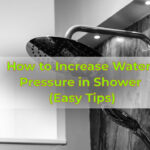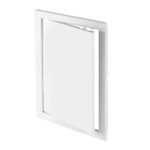Wondering on how to increase water pressure in shower? A weak stream of water can make your daily routine less enjoyable and prolong the time it takes to rinse off.
In this article, we will explore some easy and effective ways to increase water pressure in your shower. Boost it and make your showering experience amazing! You’ll be able to relish a much better shower quickly.
What Causes Low Water Pressure in Shower?

Before trying to fixing your shower water pressure, you have to investigate the reason why it is low. Here are some of the causes on why your water pressure in shower is low:
1. Clogged showerhead
Over time, mineral deposits and other debris can accumulate in the tiny holes of your showerhead, restricting the flow of water and causing frustration during your daily routine.
If you are experiencing low water pressure in your shower, one of the first things to check is the showerhead. If it appears dirty or has visible buildup, it’s likely that mineral deposits have accumulated over time. This buildup can also cause discoloration or rusting on your showerhead.
2. Water valve not fully open
The valve controls the flow of water to your showerhead, and if it’s not fully open, your water pressure may suffer.
To check if this is the issue, locate the main water valve for your home and ensure that it’s fully open. If you have an individual valve specifically for your shower, make sure that one is fully open as well. It’s possible that someone in your household may have accidentally closed the valve or turned it only partially open.
If the valves are already fully open but you’re still experiencing low pressure, there could be other causes at play. For instance, mineral buildup can clog pipes and reduce pressure over time.
In either case, addressing these issues should help restore proper water flow to your showerhead so you can enjoy a satisfying rinse once again.
3. Pressure regulator malfunction
A pressure regulator malfunction can cause low water pressure in your shower, which can be frustrating and inconvenient. The pressure regulator is a device that regulates the water pressure in your home. When it malfunctions, it can cause too little or too much water pressure, leading to issues with your plumbing system.
Low water pressure in the shower is a common problem caused by a malfunctioning pressure regulator. This problem can occur due to several reasons such as clogged pipes or a faulty valve. If you notice low water pressure specifically in your shower, then there’s a good chance that the issue lies with your regulator.
4. Water leak
Water leak causing low water pressure in the shower is a common problem in many homes. When there is a water leak, it can lead to a significant reduction of the water pressure in your shower.
A leaking pipe or faucet can cause low water pressure in your shower. The water that should be flowing into the showerhead ends up being lost through the leak instead. If you suspect that this may be the case, turn off all faucets and appliances that use water and check if your meter continues to run. If it does, then you have a leak somewhere in your plumbing system that needs to be fixed immediately.
5. Water supply issue
Water supply issue causing low water pressure is a common problem that many households face. The reduced water pressure in the shower can be frustrating and even affect your daily routine. If you are experiencing low water pressure, there are several factors to consider, including the source of your water supply.
One common cause of low water pressure is when multiple homes or buildings share a single supply line. This can lead to reduced water flow as more people use the same source at once.
How to Increase Water Pressure in Shower

Is your shower water just a slow drip? That could mean your water pressure is too low. Contact a plumber for expert advice.
If you’re confident in DIY, here’s how to increase water pressure:
1. Check for any clogged shower heads or pipes
Is your shower head clogged? or hot water pressure low but cold fine? Remove it and take a peek inside. You might find blockages or built-up minerals. Clean them out with a pipe cleaner or stiff brush to get the water pressure back up. Check also: Install Shower Drain Without Access Below.
Check all exposed pipes in your home. Look for blockages in ceramic fittings behind walls too. If you can’t find the cause, call a plumber for help.
2. Check the water valve
The water valve is the source of all water pressure in a home. If your shower pressure isn’t up to par, the first step is to check the valve. It’s usually located in the basement or a wall outside.
You can increase the pressure by turning the valve clockwise gradually. Test the pressure as you go until it reaches the desired level.
Also, make sure there are no blockages in the pipes leading from the valve, which could be causing low pressure.
3. Install a water pressure booster pump
Installing a water pressure booster pump is an effective way to improve shower water pressure. The pump uses energy to increase pressure and is great for households with low mains pressure. Before purchasing, consider the amount of water needed to be pumped. Get a pump that matches your system’s flow requirements.
When you have purchased the right pump, check the power supply is capable. Installation involves connecting hoses and pipes, then turning on the power to check it’s working correctly. Read the user manual for detailed instructions. If unsure, seek advice from professionals or local tradespeople.
When installing for showers, consider the following:
- Pipes should have minimum diameter of 15mm for maximum flow rate. Narrower pipes can cause cavitation, reducing performance & damaging pipework.
- Ventilation needs to be adequate in any enclosures surrounding equipment, so it can cool itself down.
- You may need additional equipment, like an accumulator tank, so pressurized hot showers stay at an even flow despite temperature changes.
4. Consult a plumber
Do research on the common causes of low water pressure before calling a plumber. Blockages, limescale build-up, outdated fixtures, closed valves, malfunctioning hot water tanks, pumps that are too weak, restricted water flow, and broken pipe joints are potential causes. Solutions can include replacing parts, descaling pipes, installing fixtures, and installing a booster pump.
This will help the plumber understand your system, and save time and money. Simple tasks like descaling pipes or replacing aerators can be done yourself. For more complex problems, it’s best to call a qualified professional.
How to Increase Water Pressure in Shower Apartment

If your shower has low water pressure in your apartment, take these steps to increase it. Firstly, check if there’s any debris blocking your pipes. Clean it with a pipe cleaner or snake if there is. Also, try running hot water through the line for a few minutes to remove detergents stuck to the walls.
If there’s no blockage, you may need better components. Get them at a home improvement store or online supplier. Upgrade your shower head to one with a higher PSI. And install a low-flow or high-pressure valve. Make sure it’s compatible with your current setup.
If these solutions don’t help, contact a licensed plumber. They can suggest extra solutions that don’t need expensive repairs or replacements.
How to Increase Water Pressure in Shower with Well Water
If you want higher water pressure in your shower from a well, many solutions can be used. Some need access to the well, others involve changes at home.
At the Well: If pressure is below 30 PSI and hot water isn’t hot enough, check the well. Ask a pro to look at the pump. If it’s okay, get a bigger injector pump to boost pressure.
Water Heater: If hot water isn’t hot enough, pressure can be adjusted at the heater. Ask a specialist about this. More heat means higher temperature and pressure.
Showerhead Setup: If nothing else works, buy an adjustable-flow showerhead. Get a head with several sprays and choose one for your needs. Or get higher-pressure nozzles. They increase water velocity without too much flow, and cost less than adjustable-flow models. Check also Gap Between Tub and Floor.
Low Water Pressure in Shower Only
If you’re having low pressure in the shower, you’ll want to investigate a few potential causes. A common one is a clogged showerhead. Remove it and soak it in vinegar and baking soda to get rid of any buildup. Also check fittings like washers inside the pipe threads for both the head and arm.
It could also come from an obstruction in your pipes or the main water line. If water heater sounds like a tea kettle, Check for blockages, or run a plumbing snake through your whole system. And look for damage that might be limiting plumbing lines – kinks, cracks, or broken pump seals.
Finally, if you need more pressure, try a new model with multiple jets. This can provide great coverage, and boost available water pressure.
Best shower head to increase water pressure
To up your shower water pressure, buy a new shower head! Look for high flow rate capabilities, typically 1.7 GPM or higher. Going for adjustable or multi-mode is great for customizing the pressure. Lastly, bigger nozzle openings will help you get the most out of low-flow models. Check also Shower Drain Cover Types for Replacement.
Is there a device to increase water pressure in shower?
Yes, there is a device to increase water pressure in shower.
One of the most common devices used to boost shower water pressure is a showerhead that comes with an inbuilt pump. These types of showerheads work by drawing air into their chambers, creating additional force and increasing water flow.
Additionally, you may also consider installing a power shower pump that has been specifically designed to increase your home’s overall water supply.
Do shower filters increase pressure?
The answer is no, shower filters do not increase water pressure. In fact, they may even reduce it slightly.
Shower filters are designed to remove impurities and chemicals from the water, such as chlorine and heavy metals. While these contaminants can have negative effects on skin and hair health, they do not affect water pressure. Water pressure is determined by the plumbing system and the amount of water flowing through it.
What is the highest water pressure for a shower?
In general, however, the maximum allowable water pressure for residential showers is 80 pounds per square inch (psi).
The reason why there’s a limit to the water pressure in showers is safety. High water pressure can damage pipes and fittings and even cause them to burst or leak.
I am a multi-talented designer and contractor with over 10 years of experience in the field. I have a passion for creating beautiful, innovative spaces that reflect my clients’ needs and styles. My skills include architectural design, interior design, space planning, project management and construction supervision.






